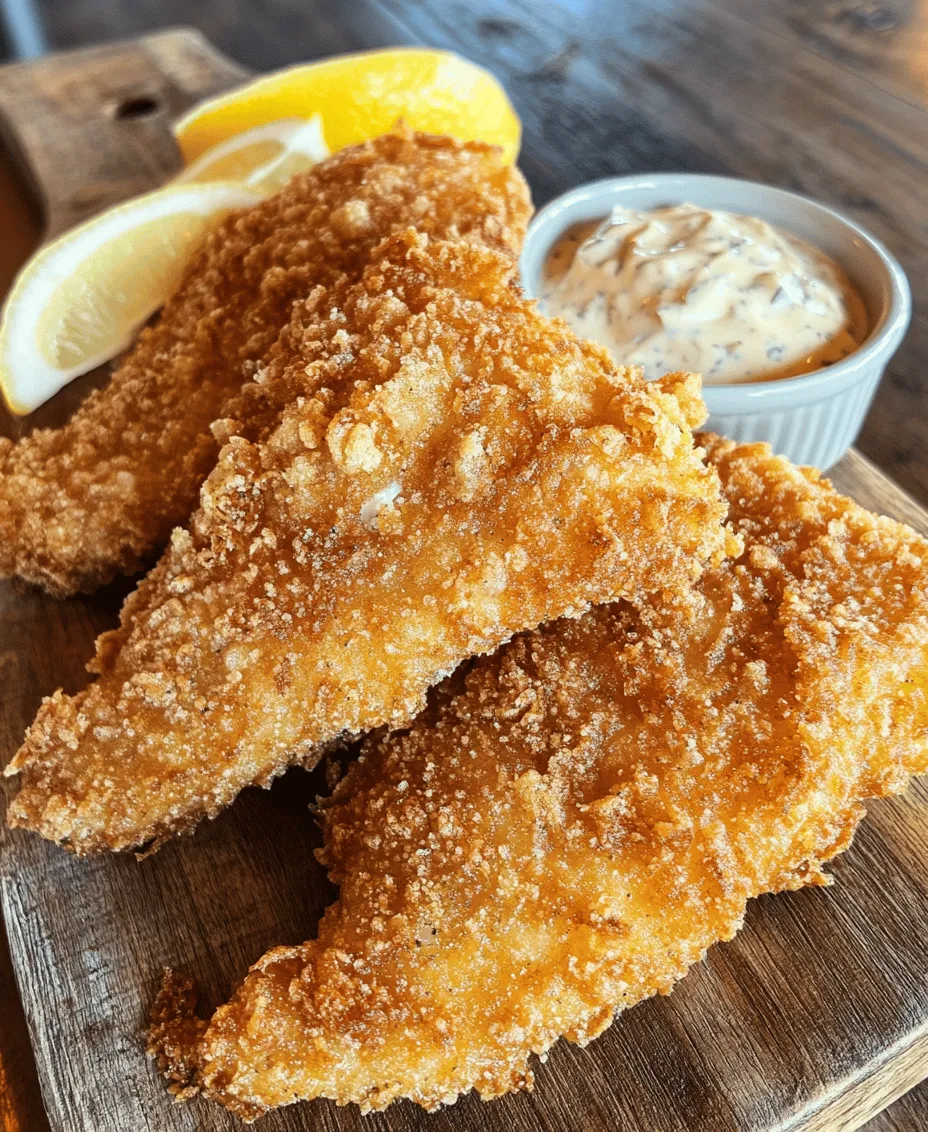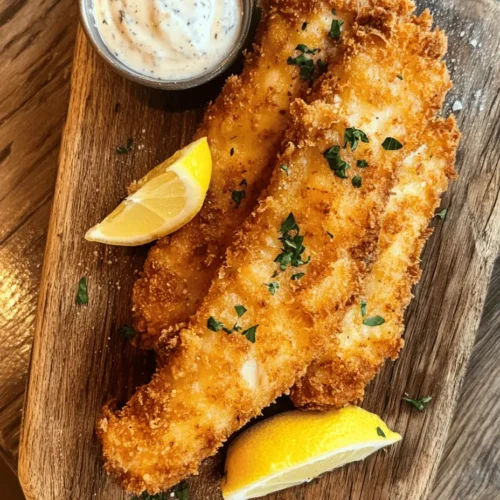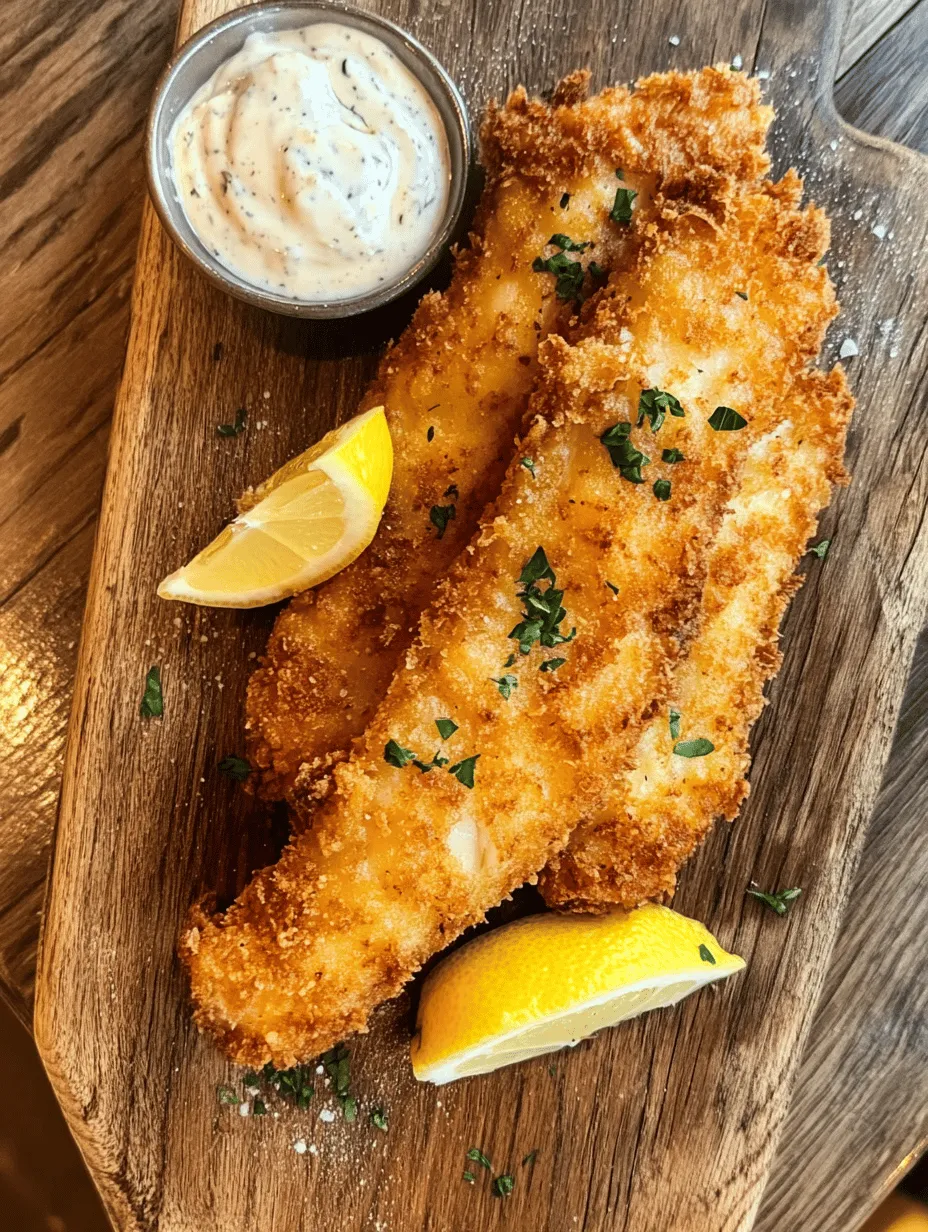Introduction
There’s something undeniably comforting about a plate of classic fish and chips. The warm, flaky fish encased in a crispy, golden batter, paired with a side of crunchy fries, has become a beloved staple in countless households. Among the various iterations of this dish, Long John Silver’s stands out as a nostalgic favorite for many, evoking memories of family outings and seaside adventures. This article will guide you through creating your very own version of the iconic Long John Silver’s inspired fish batter, right in the comfort of your kitchen.
Imagine the aroma of freshly fried fish wafting through your home, bringing everyone together for a delicious meal. Making this dish at home not only allows you to recreate that beloved flavor but also provides a rewarding cooking experience. As we delve into this crispy batter recipe, you’ll discover detailed preparation steps, ingredient insights, and serving suggestions that will elevate your culinary skills and impress your family and friends.
Understanding the Ingredients
Creating the perfect batter starts with understanding the roles of each ingredient. Here’s a breakdown of the key components that contribute to the deliciousness of your Long John Silver’s inspired fish batter:
All-Purpose Flour and Cornstarch: A Combination for the Ideal Texture
The foundation of any good batter begins with flour. For this recipe, a combination of all-purpose flour and cornstarch is essential. All-purpose flour provides the necessary structure and binding properties, while cornstarch adds a lightness that contributes to a crispier texture. This blend ensures that you achieve that sought-after crunch without compromising on the fish’s tenderness.
Baking Powder and Baking Soda: Key Leavening Agents for Crispiness
To achieve that signature crunch, baking powder and baking soda play a vital role. These leavening agents create air pockets within the batter as it cooks, resulting in a light and airy texture. The reaction between these ingredients and the moisture in the batter causes it to puff up, enhancing the overall crispiness. It’s important to measure these ingredients accurately to ensure your batter achieves the perfect consistency.
Spices and Seasonings: Enhancing Flavor Profile
While the batter is primarily about texture, enhancing its flavor is equally important. A mixture of spices and seasonings, such as salt, pepper, garlic powder, and paprika, can elevate your batter and complement the fish beautifully. These seasonings not only add depth to the flavor but also create a more complex taste experience. Feel free to experiment with different herbs and spices to customize the flavor to your liking.
Sparkling Water: The Secret to a Light and Airy Batter
One of the most crucial ingredients in this batter recipe is sparkling water. This fizzy liquid introduces carbonation, which aids in creating a light and airy texture in the batter. The bubbles in the sparkling water expand during cooking, resulting in a batter that is crispy on the outside and tender on the inside. Using ice-cold sparkling water will enhance this effect even further, giving you that perfect crunch.
Fresh Fish: Choosing the Right Type for Frying
The type of fish you select can significantly impact the overall quality of your dish. Common choices for frying include cod, haddock, and pollock. Cod, with its firm texture and mild flavor, is particularly popular for fish and chips. It holds up well during frying and has a pleasant flakiness when cooked. Haddock, on the other hand, offers a slightly sweeter taste and can also be an excellent choice. Ultimately, the best fish for your batter will depend on your personal preference, so consider experimenting with different varieties to find your favorite.
Preparation of the Fish
Before you dive into making the batter, it’s essential to properly prepare the fish. Proper preparation ensures that the batter adheres well, resulting in a beautifully coated and deliciously fried piece of fish.
How to Pat Dry the Fish for Better Batter Adherence
The first step in preparing your fish is to pat it dry with paper towels. Removing excess moisture is crucial, as it helps the batter adhere better to the fish. If the fish is wet, the batter may slide off during frying, leading to an uneven coat and less-than-ideal texture. By ensuring your fish is dry, you set the stage for a perfect crunch.
Cutting Techniques for Uniform Cooking
Next, consider the size and shape of your fish fillets. For even cooking, cut your fish into uniform pieces, ideally about 1-inch thick. This ensures that each piece cooks through at the same rate, resulting in perfectly fried fish. Additionally, if you’re using thicker fillets, you may want to make a shallow cut down the center to help the heat penetrate more evenly.
Selection of Fish: Cod vs. Haddock and Why It Matters
As mentioned earlier, choosing the right fish is paramount. Cod and haddock are both excellent options, but they each have unique characteristics. Cod has a mild flavor and is slightly firmer, making it a popular choice for traditional fish and chips. It holds up well in the frying process and has a satisfying texture. Haddock, with its slightly sweeter and more delicate flavor, also makes for a delightful dish. Depending on your taste preferences, you can opt for either fish—or even mix the two for a more diverse flavor profile.
Creating the Perfect Batter
Now that you have your fish prepared, it’s time to make the batter. Follow these step-by-step instructions to ensure you achieve the perfect consistency and flavor.
Mixing the Dry Ingredients: Achieving the Right Proportions
Begin by gathering your dry ingredients: all-purpose flour, cornstarch, baking powder, baking soda, and your chosen spices. In a large mixing bowl, combine the flour and cornstarch in a ratio of roughly 2:1. For example, if you use 1 cup of flour, add ½ cup of cornstarch. Next, incorporate 1 teaspoon each of baking powder and baking soda, along with your spices. Mix these dry ingredients thoroughly to ensure an even distribution of flavor and texture.
Importance of Whisking: Creating a Lump-Free Mixture
Once your dry ingredients are well combined, it’s time to whisk them together. A whisk is your best friend here, as it will help break up any clumps and create a light, airy mixture. Whisk until the ingredients are fully combined, and there are no lumps remaining. This step is crucial for achieving a smooth batter that clings perfectly to the fish.
Adding Sparkling Water: Tips for Achieving the Perfect Consistency
The final step in creating your batter involves adding the sparkling water. Begin by pouring in about 1 cup of ice-cold sparkling water, mixing gently with a spatula or wooden spoon. The goal is to achieve a smooth, pourable batter that is thick enough to adhere to the fish but not so thick that it becomes cumbersome to work with. If the batter is too thick, gradually add more sparkling water until you reach the desired consistency. Remember, the effervescence of the sparkling water is key to achieving that crispy result, so don’t skip this step!
With your batter prepared and your fish ready, you’re all set to move on to the frying process, where the real magic happens. In the next section, we will explore the steps for frying the fish to perfection, along with some tips for serving this delicious dish. Stay tuned as we continue our journey into the world of crispy Long John Silver’s inspired fish batter!

Frying Techniques for Optimal Crispiness
Achieving that perfect golden-brown crispiness reminiscent of Long John Silver’s iconic fish batter requires attention to detail, especially when it comes to frying techniques. The frying process plays a crucial role in the texture and flavor of your fish, so let’s delve into essential tips and tricks for optimal results.
Understanding Oil Temperature
The first step to achieving a perfectly crispy fish batter is ensuring that your oil is at the right temperature. Maintaining an oil temperature of 350°F (175°C) is vital for achieving that coveted crunch while keeping the fish tender and juicy inside.
Importance of Maintaining the Right Frying Temperature
When the oil temperature is too low, the batter will absorb excess oil, resulting in greasy fish. Conversely, if the oil is too hot, the batter may burn before the fish is fully cooked. Therefore, maintaining the right frying temperature is essential for both flavor and texture.
Tips for Testing Oil Readiness
One effective method for testing if your oil is ready for frying is the batter drop method. Here’s how to do it:
1. Drop a small amount of batter into the oil.
2. Observe the reaction: If the batter drops to the bottom and then quickly rises to the surface, the oil is ready. If it sinks without bubbling or takes a long time to rise, the oil is not hot enough. If it immediately bubbles fiercely and browns the batter, it’s too hot.
Another method is to use a thermometer, which provides a precise reading. Investing in a good-quality kitchen thermometer can help take the guesswork out of frying, ensuring consistent results every time.
Battering and Frying the Fish
Once your oil is heated and ready, it’s time to batter and fry the fish.
Techniques for Evenly Coating the Fish
To achieve an even coating of batter on your fish, follow these steps:
1. Pat the fish dry: Before battering, make sure to pat the fish fillets dry with paper towels. This step helps the batter adhere better and reduces excess moisture that can lead to sogginess.
2. Use a dredging technique: First, lightly coat the fish in flour to help the batter stick. Then, dip the fish into the batter, allowing any excess to drip off before placing it in the hot oil. This technique ensures an even and consistent coating.
Avoiding Overcrowding the Pot
When frying fish, it’s essential to avoid overcrowding the pot. Adding too many pieces at once can cause the oil temperature to drop significantly, resulting in soggy fish instead of crispy goodness. Fry in batches, giving each piece enough space to cook evenly.
Cooking Times
Cooking times are crucial for ensuring perfect doneness without overcooking. Generally, fish fillets will take about 3-4 minutes per side to cook through, depending on their thickness. Keep an eye on the fish, and when it turns a beautiful golden brown, it’s time to flip it. To check for doneness, the internal temperature of the fish should reach 145°F (63°C), and the flesh should be opaque and flake easily with a fork.
Serving Suggestions
Now that you’ve mastered the frying technique, it’s time to consider how to serve your delicious crispy fish. Presentation and accompaniments can elevate your dish from simple to spectacular.
Pairing and Presentation Ideas
Traditional Accompaniments
No fried fish dish is complete without classic accompaniments. Serve your crispy fish with a side of tartar sauce for dipping, a zesty lemon wedge for a burst of freshness, or even a sprinkle of fresh herbs like parsley for added flavor.
Recommended Sides
Enhance your meal by pairing your fish with some traditional sides. Options include:
– Fries: Crispy French fries are a classic choice that complements the fish perfectly. Consider using a thicker cut for added texture.
– Coleslaw: A refreshing coleslaw can provide a crunchy contrast to the crispy fish, balancing the richness of the batter.
– Garden Salad: A light garden salad with a tangy vinaigrette can add freshness to the meal, making it a well-rounded dining experience.
Creative Serving Ideas for a Restaurant-Style Experience
For a more upscale presentation, consider serving the fish on a wooden board with small bowls of dipping sauces. You can also garnish with fresh herbs or edible flowers for a pop of color. For a family-style meal, serve the fish alongside a large bowl of sides, allowing everyone to customize their plates.
Health Considerations
While fried fish can be a delightful treat, it’s essential to consider health aspects when frying at home.
Frying at Home: Making Healthier Choices
Choosing the Right Oil for Frying
The type of oil you use for frying can significantly impact the healthiness of your dish. Both vegetable and canola oil are excellent choices, as they have high smoke points and neutral flavors. Canola oil is particularly popular due to its heart-healthy properties and lower saturated fat content.
Managing Portion Sizes
Fried foods can be indulgent, so it’s essential to manage portion sizes. Consider serving a moderate amount of fish alongside generous portions of fresh vegetables or salads to create a balanced plate. This way, you can enjoy the flavors without overindulging.
Conclusion
Homemade fried fish has a unique charm that transforms a simple meal into a delightful culinary experience. By mastering the techniques for creating the perfect batter, frying with precision, and presenting your dish with flair, you can recreate the joy of Long John Silver’s iconic fish batter right in your kitchen.
This recipe not only delivers a satisfying crunch but also allows for customization and creativity. Whether enjoyed as a family meal or shared with friends, this dish embodies comfort food at its finest. So gather your ingredients, embrace the cooking process, and savor each flavorful bite of your crispy, homemade fish.



